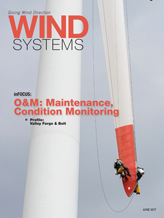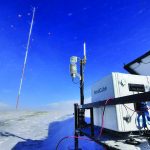If it ain’t broke, don’t fix it.
That cliché can take an ominous turn when it comes to big complex systems like the ones that make up wind-farm turbines.
In that world, when something does finally break down, it has the potential to cause a lot of damage to an unprepared company’s bottom line.
But now, with the help of the Internet of Things and the cloud, ServiceMax can give industries such as wind a leg up in detecting problems before they happen.
The Internet of Things and the cloud have come a long way in a short time to connect technology to the world. That connectivity has made it possible for industries to move from a reactive maintenance paradigm to a predictive maintenance one.
Athani Krishnaprasad, co-founder and chief strategy officer with ServiceMax, came to the table with 15 years of experience working with companies to make their service operations more efficient. ServiceMax officially began life in 2007.
“We were doing that using predictive technology, and we were obviously very passionate about it,” he said. “It was tough during that time because the cloud was very new, and the mobile devices were still old generation. So we couldn’t solve all of their problems, so we started to think how could we change the game.”
That game changer was the beginnings of how ServiceMax reimagined better field service software using the cloud.
Reactive vs. Predictive
By looking at the haphazard methods of reactive maintenance, it’s easy to see why ServiceMax searched for a better and more efficient way of approaching maintenance. And that reactive maintenance paradigm had been the traditional service model for all types of industry for decades.
Reactive maintenance would kick in when an asset developed a problem, which would spur the customer to call and report that problem. That phone conversation would start with troubleshooting and more than likely lead to a technician being dispatched to address the problem and repair it, according to Krishnaprasad.
“And that’s been the paradigm, and it’s totally a reactive paradigm,” he said. “So, what we’ve been advocating is for customers to move into a proactive predictive paradigm. Because now, with the Internet of Things, technology is becoming mainstream, and it’s becoming cheaper to connect the products into the internet and start collecting data from them so you can actually, as a manufacturer or a servicer, have a window into what’s happening with the machine without needing to do guesswork and essentially predict that something is going wrong.”

With predictive maintenance, error messages or other anomalies serve as a prognosticator of possible failure and a heads up to the operators.
The result is sending a repair team out proactively or developing a software patch before a more extensive repair becomes necessary.
“That movement toward predicting failures and preventing failures from happening before they occur is the direction in which the processes and service thinking can move because it is possible now,” Krishnaprasad said.
The predictive service paradigm not only provides benefits in terms of predicting failure and preventing downtime that would affect customers, but it also has benefits for the providers as well, according to Krishnaprasad.
“In a predictive regimen, it’s much easier to organize your services more efficiently because you have a visibility into the future, so you can organize yourself much more efficiently in terms of who goes where and how do you organize parts so they’re available to the tech when he shows up,” he said. “That prevents multiple times the tech might have to visit if he doesn’t bring the right part.”
Wind Advantage
Krishnaprasad added that the wind industry is particularly suited for this predictive maintenance.
“Wind is a great example, solar is a fantastic example as well,” Krishnaprasad said. “These are the industries that were born in the internet age. So from the get-go, any provider that is managing a wind farm or managing a solar farm connects the panels and these wind turbines into the internet from the beginning. They don’t have the legacy of having to design and produce the machines 10, 20, 30 years ago that didn’t have the internet connection available at that time.”
But he said all industries will have to eventually move to a predictive service model.
“Everyone is going to ultimately, at some point in the future, look and feel like a wind or a solar operator from the perspective that they will have the visibility from the data; they will move toward a proactive maintenance regimen,” Krishnaprasad said.
Expanding the Data
ServiceMax takes data coming in from wind farms and expands on it, according to Krishnaprasad.
“A lot of these wind operators and solar operators have gotten good at monitoring the assets in the field producing energy,” he said. “So they can pick up slow downs in performance, and they can pick up glitches, and they know that there is something wrong that requires intervention.”
ServiceMax can take that signal coming from a command center and translate it into an operational flow.
For example, ServiceMax picks up and interprets signals coming from a command center that’s monitoring a wind farm, and then automatically kicks out a work order for a technician to go out, according to Krishnaprasad.
The ServiceMax software interfaces with a monitoring system that has data coming in from assets and looks at several parameters: failure patterns, alert patterns, error-message patterns. A root engine in the command center looks at these patterns, and depending on how many times a pattern is perceived within a 24-hour period, the system determines if an asset will require some kind of intervention.
If action is necessary, the work order produced can contain vital information including assigning the right technician, creating a snapshot of the sensor data that led to the failure, and actually bringing a live feed of the failure to a tech in the field, according to Krishnaprasad.
“And that actually provides insights for the tech to be a lot more effective,” he said. “It takes the guesswork out of the job. And we make it all available on a mobile device, which works online and offline.”
ServiceMax is able to automate the process of sending someone out, and once a technician is dispatched, ServiceMax is able to capture the data from the technician’s repair and feed that back into the system, which will serve in better predicting failures and interventions in the future, Krishnaprasad said.
“We help customers close that loop,” he said.
Targeting Renewables
ServiceMax has been targeting renewables for about half a decade. It started a relationship with GE in 2010.
The company recently was acquired by GE Digital for nearly $1 billion.
Before the acquirement, ServiceMax had more than five years’ experience working with GE to enable its service deliverable processes in the renewables business. And now ServiceMax includes companies such as Siemens in its wind-division processes.

Krishnaprasad said there are similarities to how it approaches the wind industry as compared to others.
“Wind is sort of ahead of the curve compared to other segments,” he said. “They are demanding service processes that can actually slice up data. So they are much further ahead in terms of that curve that everybody else is trying to get onto. That makes it particularly interesting to work with the wind customers.”
Another element in wind that comes up more often than with other industries is safety considerations, according to Krishnaprasad.
“Specifically with wind, the assets are hard to access,” he said. “So safety concerns bring unique requirements for us in terms of being able to potentially predict issues. For example, if the mobile device the technician is carrying falls, we can detect that through an accelerometer and predict some potential safety issues. The tech has to climb 500 steps on a ladder to get up to the asset, which makes it very hard for them to go back-and-forth from the truck to the top of the wind turbine. That means it’s very important for us to enable this tech to know every piece of information he or she needs to be effective up there and make sure we send up all the parts that will be required.”
Wind creates unique factors simply due to the settings where wind technicians have to work, according to Krishnaprasad.
“Those are some of the interesting nuances we’ve learned to address in our product, and we have built features around those because of the interaction with the wind industry,” he said.
“Hidden Gold Mine”
Because of the potential savings that can be a product of predictive maintenance, Krishnaprasad said ServiceMax approaches customers with that economic advantage in mind.
“We talk about service operations management as a hidden gold mine in these companies in terms of the value we can extract from it,” he said. “Both from a productivity and efficiency cost savings point of view, but also in terms of moving the needle on the top line growth.”
Along with certain metrics that ServiceMax measures, it also produces an annual survey that shows its customers have seen about an 18 percent increase on average in productivity, a 12 percent increase in terms of efficiency, and a 12-15 percent increase in revenue, according to Krishnaprasad.
“These are the same parameters that actually are applicable to the wind industry,” he said. “They’re looking for efficiencies; they’re looking for effectiveness when the tech goes up that ladder as well as overall workforce productivity.”
Wind farms employ dozens of techs, so ServiceMax is able to know how to optimally dispatch technicians so they’re not wasting time driving from place to place. It can also ensure those techs have the skills needed to solve a particular problem, Krishnaprasad said.
“All of these things matter,” he said. “But in addition to that, I think the conversation we have with the wind industry specifically is the safety considerations.”
Broader Platform
And becoming a part of GE Digital has given ServiceMax a much broader platform to be involved globally about its predictive maintenance platform, according to Krishnaprasad.
“Especially in energy,” he said. “All the power generated on the planet Earth, GE technology is used in half of that. That spans across fossil fuels, hydro, and renewables, both solar and wind. So we have both now the ability to ride the GE relationship into these big industries across the globe and bring value and have meaningful conversations.”
And with GE Digital also being a pioneer of the industrial Internet of Things, it has been able to gear the platform toward industrial segments that speak to the depth of security, volume, and cloud performance to be able to predict failures fast, Krishnaprasad said.
“We can truly sort of move the needle on what it means to service modern assets through modern technologies like ServiceMax,” he said.



































